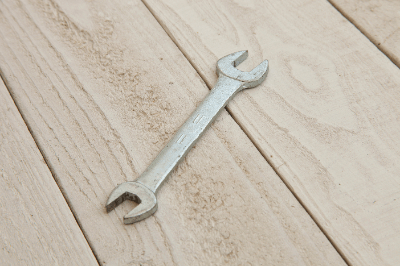What Is a Double Open-End Spanner?
 A double open-end spanner (wrench) is a tool used primarily for tightening and loosening hexagonal bolts and nuts.
A double open-end spanner (wrench) is a tool used primarily for tightening and loosening hexagonal bolts and nuts.
The part that grips the bolt or nut is called the “bore,” and the width of the U-shaped opening is called the “two-sided width. A single-end spanner has a bore on only one end, whereas a double open-end spanner has bores on both ends.
The distinction between a wrench and a spanner is not clearly defined; “spanner” is the term used in British English, while “wrench” is the equivalent term in American English.
Uses of Double Open-End Spanners
The double open-end spanners are tools used in various applications, from general DIY to professional workplaces. It is mainly used for tightening and loosening hexagonal bolts and nuts. They are useful in all kinds of situations, including machinery and equipment, precision instruments, vehicles, engines, construction, furniture, and DIY.
The double open-end spanner has a U-shaped open-end so that it can be inserted from the side. Therefore, they are used for working on bolts and nuts in tight spaces. The double open-end spanner is not a tool suitable for applying large force because it supports and tightens at two points. Therefore, it is generally used for temporary fastening.
Most double open-end spanners have two different sizes of bore widths at both ends. Compared to one-ended wrenches, the number of wrenches to be kept together is reduced, making them easier to carry and manage.
Principle of Double Open-End Spanners
Double open-end spanners use the “leverage principle” to tighten or loosen a bolt or nut by generating a large force with a small force. The fulcrum is the center of the bolt or nut. The force point is where the hand holds the double open-end spanners, and the action point is the angle between the bolt or nut and the spanner.
By holding and turning the end of the double open-end spanners, the bolt or nut can be easily tightened or loosened. The double open-end spanner has two points of contact with the bolt and nut, while the wrench has six points of contact. As a result, the wrench can apply more force to tighten the bolt and nut.
Types of Double Open-End Spanners
1. General Double Open-End Spanners
Both ends of the handle have a bore section that grips the bolt or nut. The two side widths are fixed.
2. Thin Spanner
This is a thinner spanner than usual. It is used for work in tight spaces or when the bolt or nut is thin. It is not suitable for large bolts and nuts but is useful for small bolts and nuts.
How to Select Double Open-End Spanners
Using double open-end spanners that suit your work purpose will affect the work efficiency, safety, and accuracy of the finished product.
1. Size
The part that clamps the bolt or nut is fixed, so select a wrench that matches the size of the bolt or nut. The size is not the diameter or radius, but the distance between the “two side widths” where the double open-end spanners fit the bolt or nut.
The size is usually written in meters on the handle. However, in rare cases, some are listed in inches, so it is recommended to check.
2. Set
Since double open-end spanners are used frequently, it is convenient to have several sizes of double open-end spanners in a set.
3. Similar Products
There are wrenches (eyeglass wrenches) with a circular bore. Since the bore touches the entire circumference of the bolt or nut, it is difficult to dislodge the bolt or nut, and it is difficult to tamper with.
There is also a one-ended wrench with a bore on only one side, and a combination wrench consisting of both a wrench and a wrench.
Other Information on Double Open-End Spanners
How to Use Double Open-End Spanners
- Tighten the bolt or nut by turning it by hand.
- Place the bolt or nut firmly so that it fits into the deepest part of the bore. The bore should be parallel to the bolt and nut.
- The nut or bolt is tightened by turning the double open-end spanner. It is easier to transmit power more efficiently if you hold the end of the handle and turn it.
- When handling in a confined space, the angle of rotation may be limited. In such a case, remove the wrench from the fastening part once and re-hang it.
To loosen a bolt or nut that is stuck in a hard and tight position, oil it and leave it for a while before turning it. Also, if the angle is not good enough to reapply the wrench as it is, turning the wrench over will change the angle at which the two-face width is applied, allowing the wrench to be reapplied.